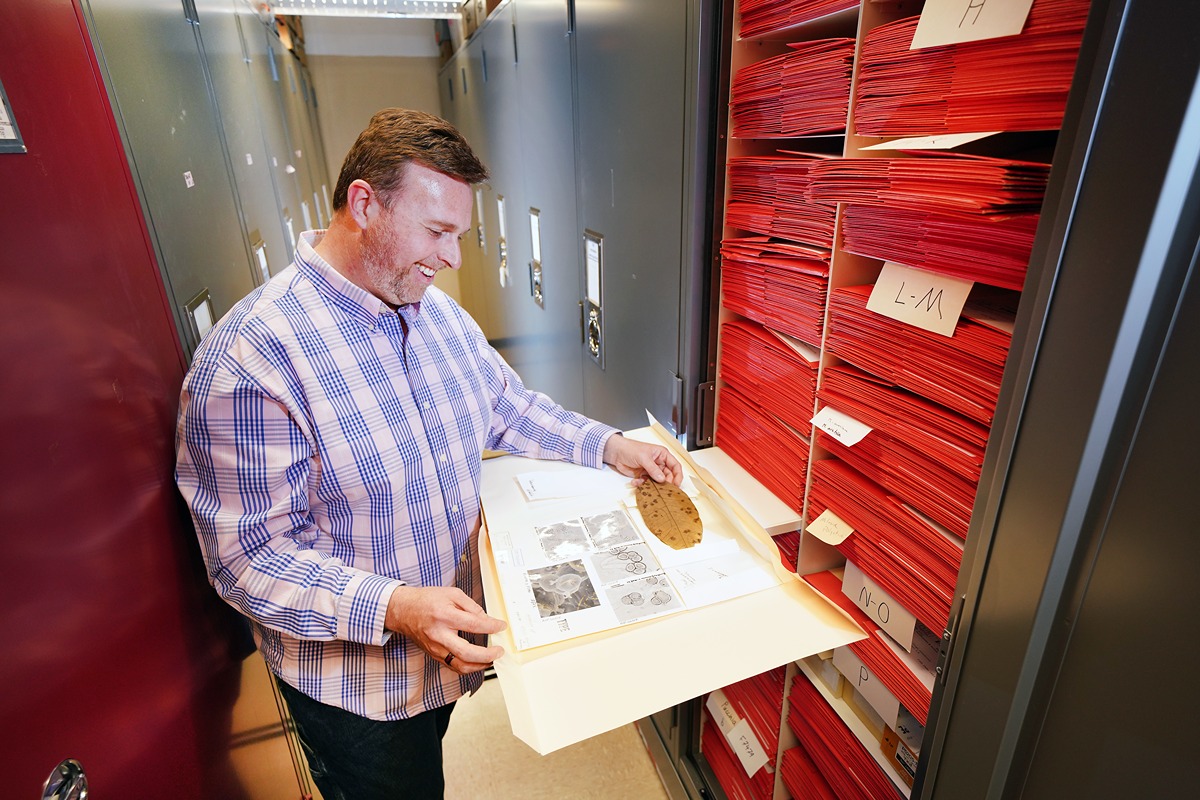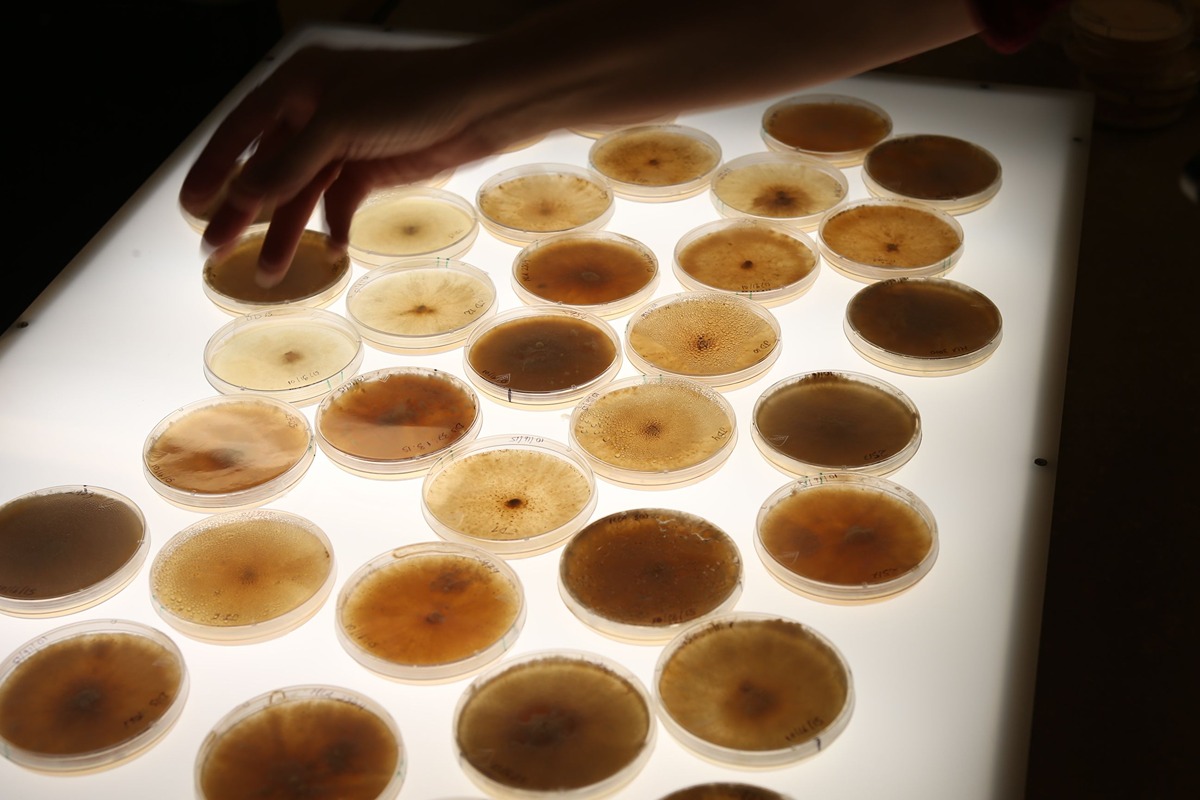More than mushrooms—what do the mycologists at Purdue study?
What do the mycologists at Purdue study?
Mushrooms, whether eaten, used medicinally or in art, are deeply intertwined with global cultures. But they actually constitute a small piece of the fungal world. Mushrooms are the fruiting body of fungi—the reproductive structure of a much larger entity.
Depending on the species, the rest of the fungus lives underground, inside decaying matter, in symbiosis with plants and animals, in wastes or in water. Webs of long, thin strings of cells, called hyphae, grow within or on their substrates to extract nutrients and water like microscopic roots. While mushrooms only show up in two groups of fungi—the basidiomycetes and ascomycetes—other fungi reproduce through different fruiting body types. All are crucial to ecosystems and have roles both beneficial and harmful to humans, many yet to be discovered.
Several fungi researchers, called mycologists, in Purdue University’s College of Agriculture study how fungi work and what doors they may open for humanity’s future:
Cathie Aime & her mycology lab
Humans have been working and fighting with fungi longer than they’ve known of its existence. For instance, yeast—a microscopic fungus made of only a single cell—is a natural component of air, water and decaying plant material. Some strains of it caused infections while others became staples for baking bread and fermenting beer—all long before microscopes showed people what they were interacting with.
 Cathie Aime, a professor of botany and plant pathology, says that scientists of the modern world haven’t even scratched the surface of the hidden fungi world. “We estimate that we have formally described less than 2% of the fungal species that exist. So scientists are still trying to discover, describe and name all of the fungal diversity that is out there.”
Cathie Aime, a professor of botany and plant pathology, says that scientists of the modern world haven’t even scratched the surface of the hidden fungi world. “We estimate that we have formally described less than 2% of the fungal species that exist. So scientists are still trying to discover, describe and name all of the fungal diversity that is out there.”
Aime and her collaborators go on expeditions around the world to find new fungi and mushrooms and describe their roles in the ecosystems of specialized environments. From Guyana’s virgin rainforests to Cameroon, the group has identified over 140 new species and eight new genera.
They transport these samples back to the Aime lab in West Lafayette to sequence their genome and preserve specimens for the Purdue University Herbaria and other culture collections around the world. These fungi can be further examined both now and years down the line when advancements in technology might allow researchers to answer more questions from them.
“These discoveries are a win for science because new species can be examined for new metabolites, useful compounds, food sources and more,” Aime said. “But we also discover new ecological roles that fungi play in the environment—every species is adapted for some specific niche, and part of the fun of what we do is discover what those niches are.”
 Fungi form relationships with other organisms, including plants, animals, bacteria and other fungal species, in their ecosystem. Over 90% of plants, for example, are thought to form “mycorrhizal” connections with fungi in the soil, feeding them carbohydrates and using them as an extension of the root system to pick up more nutrients. Often, each member of these partnerships couldn’t live without the other.
Fungi form relationships with other organisms, including plants, animals, bacteria and other fungal species, in their ecosystem. Over 90% of plants, for example, are thought to form “mycorrhizal” connections with fungi in the soil, feeding them carbohydrates and using them as an extension of the root system to pick up more nutrients. Often, each member of these partnerships couldn’t live without the other.
Aime added, “Fungi also do a vast amount of the decomposition on earth, especially of materials that bacteria can’t decompose. Without the action of these fungi, there would be no carbon and nutrient cycling on which all other organisms depend.”
These ecological roles are integral to understanding the domino effects of human actions on the environment. Changing climates could force organisms, even microscopic fungi, to change roles or die trying—setting off a chain reaction of other species’ collapse.
For instance, the Aime lab recently discovered a new genus from the Guiana Shield in South America that “forms obligate associations with termites and bacteria. It provides necessary supplements to termite diets where it grows. And, termites are some of the biggest contributors to biomass in these ecosystems,” she said.
Aime spent the past two years at National Science Foundation (NSF) as a rotating program officer,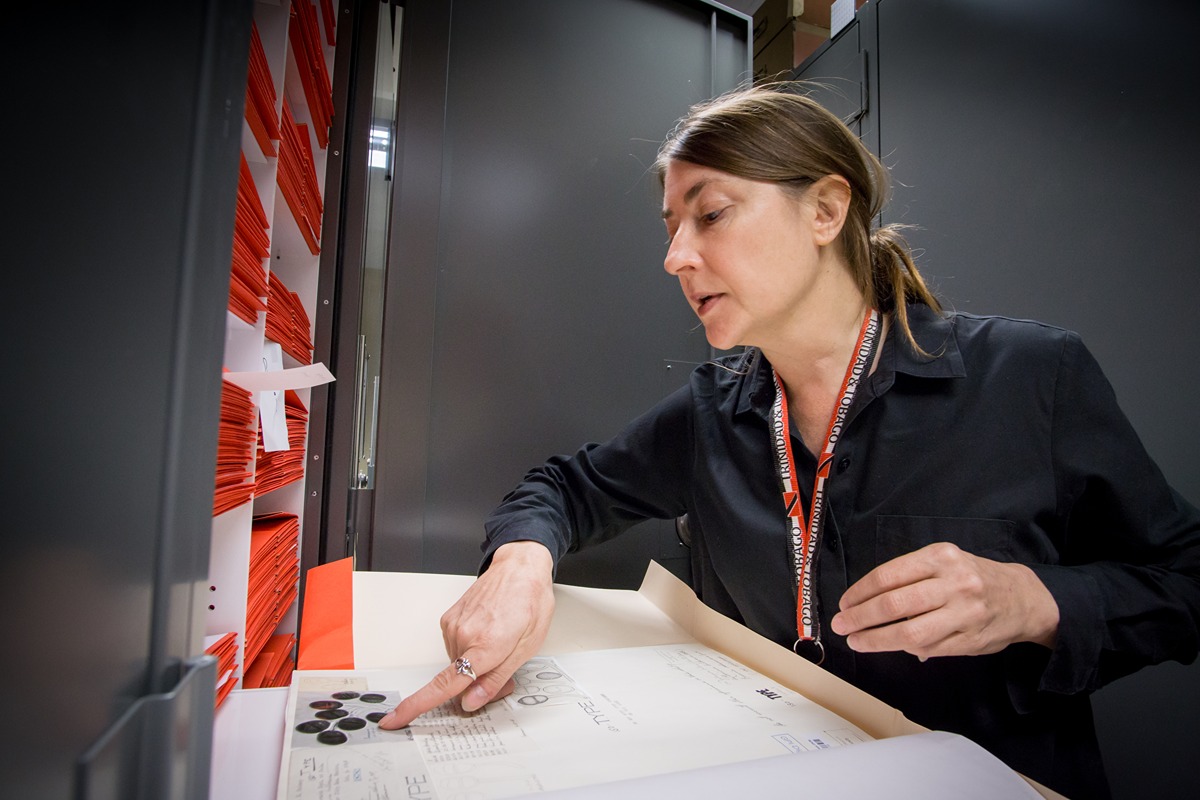 “helping principal investigators write successful grant applications, determining funding outcomes for proposals and developing new programs or areas of emphasis for biological research.”
“helping principal investigators write successful grant applications, determining funding outcomes for proposals and developing new programs or areas of emphasis for biological research.”
She also recently finished a year-long appointment as president of the Mycological Society of America and then was voted president-elect of the International Mycological Association, a global fungal society with over 80 countries involved in their latest meeting. Aime said that these positions, as well as her work with NSF, have broadened the way she sees her science and appreciates mycology.
Rabern Simmons & the Purdue Herbaria
Rabern Simmons, the curator of fungi at the Purdue University Herbaria under the direction of botany and plant pathology professor Aime, is a specialist in the little and little-known. From colorful slime molds in the protista kingdom to a cordyceps “club head” fungus that infects fire ants, Simmons’ career has revolved around understanding the biodiversity of beings small enough they’re often overlooked.
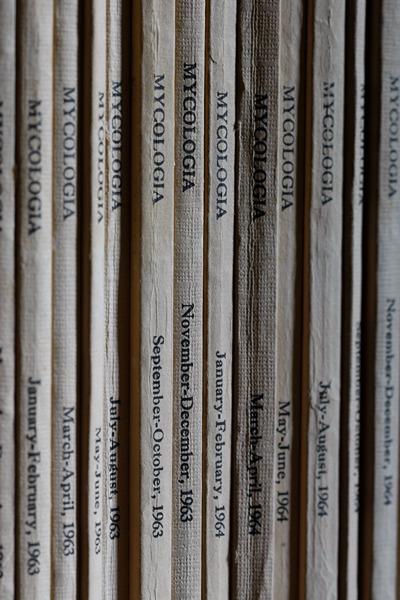 Simmons is well-known for his work with Timothy James and Joyce Longcore on the chytridiomycetes division of fungi. Chytrids are microscopic fungi that live in soil and water and, unlike mushrooms, can freely move. They have flagella—thin twirling hair-like strands—that propel their spore stages around to colonize new areas. Simmons described the evolutionary tree of many chytrid species and named nearly twenty, among other novel groups of genera, families and orders.
Simmons is well-known for his work with Timothy James and Joyce Longcore on the chytridiomycetes division of fungi. Chytrids are microscopic fungi that live in soil and water and, unlike mushrooms, can freely move. They have flagella—thin twirling hair-like strands—that propel their spore stages around to colonize new areas. Simmons described the evolutionary tree of many chytrid species and named nearly twenty, among other novel groups of genera, families and orders.
Purdue has been a hub for chytrid research since the 20th century. Mycologist John Karling served as the head of the department of biological sciences at Purdue from 1948 to 1958, and his chytrid research lives on in his books located at the Herbaria.
After Simmons’ mentor Longcore isolated chytrids from blue poison dart frog skin in 1997 to help diagnose a problem at the Smithonian’s National Zoo, the small fungus became a much bigger deal. This one chytrid species, Batrachochytrium dendrobatidis, is now estimated to have infected over 500 amphibian species, dramatically reducing populations around the world. Simmons says that stories like this are why the unknown is valuable.
“Dr. Longcore always said—and it’s become my mantra, too— ‘Look. Look. Look.’ You never know what you might find,” he recalled.
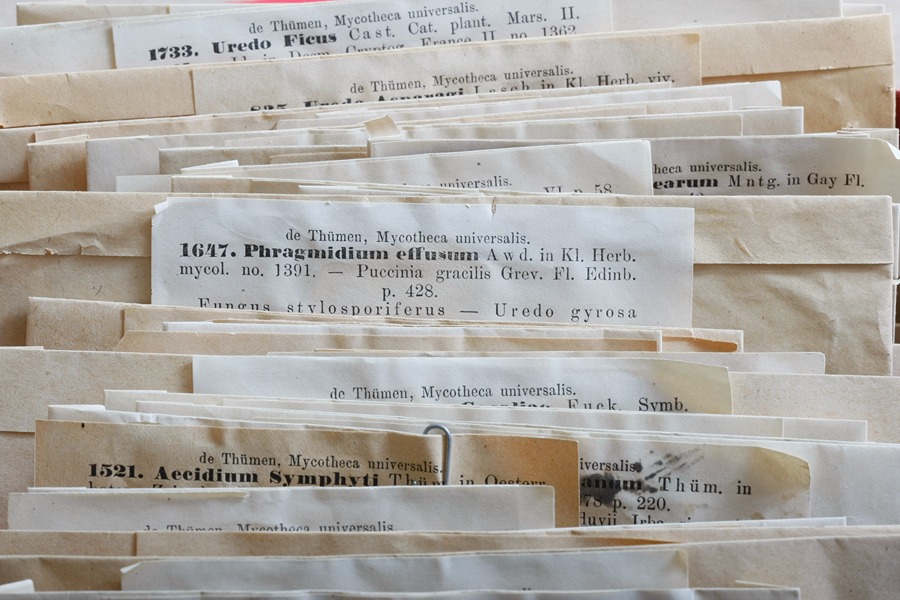 His historical work with chytrids has gained Simmons membership into the International Union for Conservation of Nature Species Survival Commission (IUCN SSC), the largest volunteer conservation-science network in the world. The IUCN SSC is hoping to identify which organisms need the most immediate resources for conservation. Simmons and his group, focusing on aquatic fungi, are the first preparing to shine a spotlight on chytrids and other underrepresented fungi.
His historical work with chytrids has gained Simmons membership into the International Union for Conservation of Nature Species Survival Commission (IUCN SSC), the largest volunteer conservation-science network in the world. The IUCN SSC is hoping to identify which organisms need the most immediate resources for conservation. Simmons and his group, focusing on aquatic fungi, are the first preparing to shine a spotlight on chytrids and other underrepresented fungi.
Simmons poses the questions, “How do we know that what we’re doing to the environment doesn’t affect microscopic populations?” And, “how do we know what will affect our environment and us in return?”
When he is not looking over the Aime Lab’s 7,000 live cultures of fungi and the Purdue Herbaria’s 235,000 dried specimens of both fungi and plants, Simmons seeks to inspire the next generation of mycologists, even giving presentations at local libraries and zoos.
For fellow mycological enthusiasts, Simmons enjoys meeting with visitors to the Herbaria in Lilly Hall from 8:30 a.m. to 4:00 p.m. on weekdays, appreciating some advanced notice for him to set out the most exciting samples for viewing.
Marshall Porterfield & Mycoponics
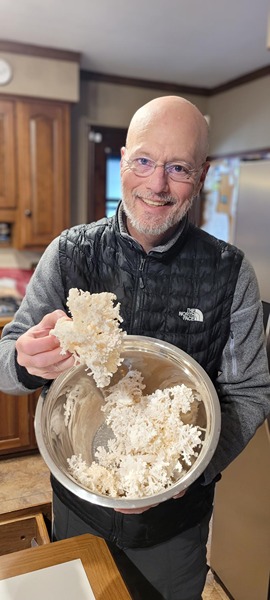 From eating a poisonous fly agaric—the iconic red-with-white spots toadstool—as a child and getting his stomach pumped to later making clay versions of the same mushroom on a “Smurfs”-themed Mardi Gras float, Marshall Porterfield has gone from picking mushrooms off his pizza to growing them in the lab.
From eating a poisonous fly agaric—the iconic red-with-white spots toadstool—as a child and getting his stomach pumped to later making clay versions of the same mushroom on a “Smurfs”-themed Mardi Gras float, Marshall Porterfield has gone from picking mushrooms off his pizza to growing them in the lab.
Porterfield, a professor in the departments of agricultural and biological engineering and horticulture and landscape architecture, has been piecing together the puzzle on what humans will need to live for extended periods on the moon and other celestial bodies since working on his PhD and later as division director for space life and physical sciences at the National Aeronautics and Space Administration (NASA).
The professor of biological engineering and space biophysics specifically focuses on building bioregenerative life support systems that will make life in space and other planets sustainable. Food scraps, fecal matter and even exhaled carbon dioxide can all become toxic in a closed system.
Mushrooms play a big part in solving this problem. “One of the components of bioregenerative technologies that has been under-studied are the nutrient recyclers of our ecosystems. Microbial systems and fungi are the best recyclers, and people do a lot of work with microbes, but fungi are almost like a hidden world.”
Porterfield and his business partners launched MyCo with the Purdue Innovates Office of Technology Commercialization last year, a company that aims to commercialize patented new ceramic technology called “mycoponics.” Like hydroponics, where plants are grown in water without soil, plants and mushrooms alike can grow on the mycoponic tubes. The pores of the ceramic material are small enough that hyphae cannot grow through, but water and nutrient solutions can still travel across the material to feed them.
“This completely new technology allows us to remove practically any fungi from any kind of substrate,” Porterfield said. “Instead, we use pure liquid culture, and we can go from spore to hyphae to mushroom back to spore.”
Porterfield is invested in figuring out which mushrooms are most useful for space exploration. One of his endeavors is turning the mass of hyphae cells—the underground, inedible part of the mushroom—and pressing it down into a strong but flexible material that can be used to create clothing.
These innovations are also significant for sustainability on Earth. Finding new ways to convert waste into food and material could be important in the fight against pollution and climate change. Porterfield says mycoponics will also offer mycologists a new method to grow and study hard-to-culture fungi.


